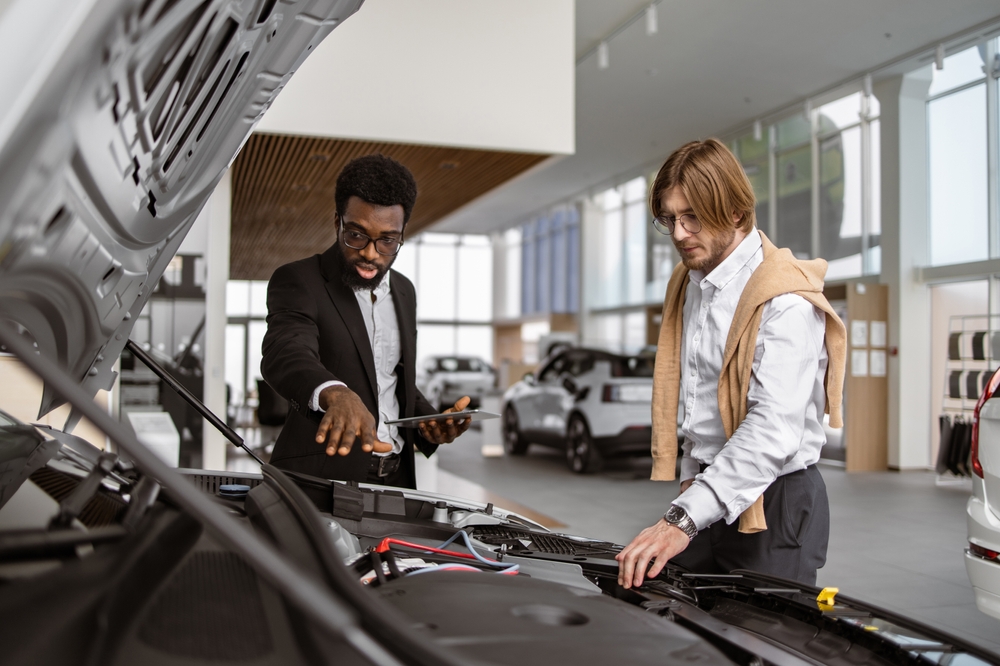
Blog

How to Sell Without Discounts: The Psychology of Value in Car Sales

Every sales manager knows the feeling. A busy Saturday, the floor is full of prospects, and the energy is high. But when you run the numbers at the end of the day, the gross profit is nowhere near what it should be. The culprit? Habitual discounting. Price isn’t the real problem in your dealership; it’s a symptom of a much deeper issue: a failure to build and communicate value. When your team defaults to slashing prices to close a deal, they aren’t just giving away money. They are eroding your brand, training customers to expect less, and leaving tens of thousands of dollars on the table every single month.
This isn’t about eliminating negotiation. It’s about fundamentally changing the conversation from “What’s your best price?” to “Is this the right vehicle for you?” We will explore the psychology of value in car sales and provide a practical framework to help your team sell with confidence, protect your gross profit, and create customers who are loyal because of the experience, not the discount. This is how top-performing dealerships win—not by being the cheapest, but by being the most valuable.
When You Lead With Discounts, You Train Customers to Wait for Them
Imagine this scenario: a dealership invests heavily in a weekend sales event. They blast emails, run social media ads, and send out a massive direct mail campaign, all screaming about “unbeatable prices” and “rock-bottom deals.” The traffic is huge. Customers pour onto the lot, waving mailers and asking, “How much can you knock off this one?” The sales team, following the lead from marketing, immediately jumps into price negotiations. They sell a lot of cars, but the gross profit on each unit is razor-thin. By the end of the month, the store has moved metal but hasn’t moved the needle on profitability.
This isn’t a hypothetical. It’s the reality for countless dealerships that have conditioned their market to value discounts above all else. When your entire message revolves around price, you attract customers who only care about price. You train them to ignore the quality of your inventory, the expertise of your staff, and the security of your service department. You teach them that the real deal only happens after a negotiation, so they arrive with their guard up, ready for a fight instead of a conversation. This approach creates a transactional, low-trust environment where your team is always on the defensive, forced to justify a price they were never taught to defend.
The Hidden Cost of Price-Driven Selling
That “small” $500 discount your salesperson gave away to close a deal doesn’t seem like much on its own. But what happens when that becomes the standard operating procedure for your entire team? If your dealership sells 100 cars in a month and gives away an average of just $500 per unit, you’ve just erased $50,000 in gross profit. Annually, that’s a staggering $600,000 hole in your bottom line. That isn’t just lost revenue; it’s money that could have been used for facility upgrades, better employee compensation, more effective marketing, or strategic inventory acquisition.
The cost isn’t just financial. Every time a salesperson offers an unearned discount, they lose a little bit of confidence. They begin to believe the vehicle isn’t worth its sticker price. They start the sales process anticipating the price objection instead of focusing on building a connection and demonstrating value. This defensive posture is felt by the customer, who in turn becomes more skeptical. It creates a self-fulfilling prophecy where price becomes the only tool your team knows how to use, leading to a downward spiral of shrinking margins and weakened salesmanship.
Confidence, Not Coupons, Closes Deals
The most successful salespeople and dealerships have made a critical mental shift. They understand that a vehicle’s price is just one component of its overall value. True sales mastery—the kind that protects gross and builds a loyal customer base—comes from confidence. It’s the confidence to stand behind your product, the confidence to guide a customer through a structured process, and the confidence to explain why your dealership is the right place to buy, regardless of a few hundred dollars.
Selling on value is about mastering car sales psychology. It’s about understanding that customers are buying more than just a machine; they are buying a solution to a problem. They are buying freedom, safety for their family, a symbol of their success, or the reliability to get to work every day. Gimmicks and discounts are temporary fixes for a lack of confidence. When your team is equipped with the right language, mindset, and process, they no longer need to rely on coupons to close deals. They can command the conversation, build unshakeable value, and make the price a logical conclusion, not a painful obstacle.
Why Discounts Destroy Profit (and Your Brand)

When a dealership’s primary sales strategy is to undercut the competition on price, it enters a battle it can never truly win. This approach not only decimates gross profit but also inflicts long-term damage on the brand’s reputation and the sales team’s morale. Understanding the deep-seated issues with discounting is the first step toward building a more resilient and profitable sales process.
The Profit Math No One Talks About
Let’s make the numbers plain. A $500 discount on 100 units is $50,000 off your bottom line. A $750 discount across 150 units is $112,500 in lost gross. This isn’t just about a single bad month; this is a systemic bleed of the profit that keeps your dealership healthy. This is the money that funds everything—from payroll and benefits to the marketing budget that brings customers in the door.
When general managers look at their P&L statement and wonder why their net profit is so low despite high sales volume, the answer often lies in the accumulated effect of these “small” discounts. It’s a death by a thousand cuts. A value-based car sales approach turns this equation around. Instead of asking, “How much can we give away?” it asks, “How much value can we build to protect every dollar of potential profit?” This mindset shift is essential to increase gross profit sustainably.
The Psychological Trap of ‘Deal Mentality’
When you consistently advertise and lead with discounts, you create a “deal mentality” in your customers. They learn that the sticker price is just a suggestion and that your first offer is never your best. This erodes the perceived value of your inventory before a salesperson even says hello. Customers become suspicious, wondering what’s wrong with a vehicle that needs to be discounted so heavily. It makes them question the integrity of your pricing and, by extension, your dealership.
This psychological trap forces your team into a corner. They spend their time defending against objections instead of proactively building excitement. The conversation is no longer about finding the perfect car; it’s about haggling over a few hundred dollars. This framework positions the dealership as a commodity, no different from any other store down the street, and the only differentiator becomes price. True brand loyalty is built on trust and experience, not on who offered the last and lowest number.
Why ‘Beating the Other Dealer’ Is the Wrong Game
Competing on price is a race to the bottom. There will always be another dealer willing to lose a little more money to make a sale. Chasing this model is not a strategy; it’s a surrender. The moment you decide to play their game, you’ve already lost control of your profitability and your brand identity. The smarter pivot is to change the game entirely. Instead of matching a competitor’s discount, differentiate your dealership on factors they can’t easily replicate.
This is where your unique value proposition comes in. Do you offer a lifetime powertrain warranty? A dedicated team of certified technicians? A streamlined, one-hour delivery process? A robust community involvement program? These are the pillars of a strong brand that justify a fair price. The goal of a value-based dealership training is to teach your team how to articulate this differentiation so powerfully that a customer wouldn’t dream of going elsewhere to save a few bucks. You stop playing their game and make them play yours.
The Mindset Shift from Transactional to Transformational Sales
A transactional sale is about moving a unit. A transformational sale is about solving a customer’s problem and improving their life. The first is driven by price; the second is driven by value. The mindset shift required is to stop seeing yourself as a car seller and start seeing yourself as a trusted advisor. You are not just facilitating a purchase; you are guiding someone through one of the biggest financial decisions they will make.
This shift changes everything about the car dealership sales process. The focus moves from the product’s features to the customer’s needs. The language moves from cost to confidence, from payments to peace of mind. When a salesperson truly believes they are providing a transformational service—delivering safety, reliability, and a positive ownership experience—they sell with an entirely new level of conviction. This conviction is contagious and gives them the authority to hold gross because they know they are delivering value far beyond the price tag.
How to Shift to Value-Based Language
Moving from a price-driven to a value-driven sales culture requires more than just a new policy; it requires a new vocabulary. The words your team uses shape a customer’s perception and determine whether the conversation will be about cost or confidence. Here are five practical steps to retrain your team’s language.
Step 1 – Reframe What You’re Actually Selling
Your team is not selling a 2.5-liter engine, a panoramic sunroof, or all-wheel drive. Those are features. What you are actually selling is the outcome of those features. You are selling the confidence of knowing you can merge onto the highway with ease. You are selling the feeling of an open, airy cabin on a beautiful day. You are selling the peace of mind that comes with knowing your family will be safe in any weather condition. Reframe every feature into a benefit, and every benefit into an emotion. This is the foundation of car sales psychology.
Step 2 – Use Emotional Anchors Instead of Price Anchors
A price anchor is when a salesperson says, “This one is $35,000, but I can probably get it for you for $33,500.” They’ve just anchored the conversation to price. An emotional anchor, on the other hand, connects the vehicle to the customer’s life. It sounds like, “Imagine not having to worry about fitting all the kids’ sports gear in the trunk anymore,” or “This car has the highest safety rating in its class, which is something our customers with young families really appreciate.” Emotional anchors create perceived value and make the price a secondary consideration.
Step 3 – Make the Customer Feel Ownership Before the Price Comes Up
The test drive is your most powerful tool to sell without discounts. It’s the moment when a customer transitions from a logical evaluator to an emotional participant. Your team’s language should facilitate this shift. Use assumptive phrases that encourage mental ownership. Instead of “if you buy it,” say “when you take it home.” Instead of asking what they think of the car, ask, “Where’s the first place you’ll drive this when you leave the dealership?” This visualization helps the customer build an emotional connection to the vehicle, making it much harder to walk away over a small price difference.
Step 4 – Use Storytelling to Justify Value
Facts tell, but stories sell. A list of features is forgettable, but a relatable story sticks. Train your team to collect and share stories that illustrate a vehicle’s value. For example, when discussing reliability, they could say, “We had a family trade in this exact model last week. They put over 200,000 miles on it with just regular maintenance. They loved it so much they bought the new version. That’s what dependability feels like.” A story like this is more persuasive than any spec sheet because it provides real-world proof of the vehicle’s worth.
Step 5 – Reinforce Value Throughout the Process
Building value doesn’t stop once a price is agreed upon. It must be reinforced at every single touchpoint. A sincere thank-you text after the test drive, a call from the service manager to introduce themselves, and a flawless, celebratory delivery experience all cement the customer’s belief that they made the right choice at the right place. This consistent reinforcement of value is what turns a one-time buyer into a lifelong advocate for your dealership. It validates their decision and makes them feel like a valued partner, not just another transaction. Mastering this is key to a successful car dealership sales process.
3 Phrases That Build Perceived Value Instantly
Sometimes, small changes in language can have a huge impact. Training your team to integrate the following phrases into their conversations can immediately shift the focus from price to value and build the customer’s confidence.
Most of Our Buyers Choose This Model Because…
This phrase leverages the power of social proof. It reassures the customer that they are making a popular and validated choice. By stating that others have chosen this vehicle for a specific reason (e.g., “…because of its unmatched safety features” or “…because its fuel economy is the best in its class”), you are calming their fears and building trust. It subtly tells them that they are joining a smart group of people who have already done the research.
Here’s What That Feature Actually Does for You…
This is the ultimate tool for translating features into benefits. Instead of just pointing out “adaptive cruise control,” a skilled salesperson will say, “Here’s what that feature actually does for you: on long highway drives, it reduces fatigue by automatically maintaining a safe distance from the car ahead, making your road trips much more relaxing.” This connects a technical term directly to a personal, emotional benefit, making the feature—and its cost—instantly justifiable.
I Completely Understand — Let Me Show You Why Our Customers Still Choose It
This phrase is a masterclass in handling price objections without being defensive. It starts with empathy (“I completely understand”), which validates the customer’s concern and lowers their guard. Then, it pivots directly back to value (“…let me show you why our customers still choose it”). This allows the salesperson to regain control of the narrative and reinforce the dealership’s unique selling proposition, whether it’s a superior warranty, a higher level of service, or the vehicle’s long-term reliability. It acknowledges the price concern while skillfully refocusing the conversation on value.
Each of these phrases works because they shift the focus from cost to confidence—and from hesitation to ownership. Practice them daily until they feel natural.
Train Your Team to Sell Value, Not Price
You can’t expect your team to adopt a value-based selling approach without the right tools and training. To help you implement these strategies and protect your gross profit on every deal, we’ve created a comprehensive training resource.
Download the Value-Based Sales Training Workbook
Inside this free workbook, your team will learn how to reframe conversations, build confidence, and protect gross profit on every deal. It contains scripts, role-playing exercises, and checklists designed to make value-based car sales a core competency of your dealership. This isn’t just theory; it’s a practical, actionable guide to transforming your sales process.
Used by top-performing dealership teams nationwide.
This guide provides the framework for a powerful shift in your sales culture. By focusing on the psychology of value, you empower your team to sell with confidence, protect your margins, and build a brand that customers trust for the long haul. It’s a more challenging path than simply dropping the price, but it’s the only one that leads to sustainable, long-term profitability.









